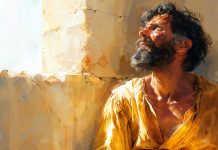For the chained man, there were now only two options: unreserved submission to the council or condemnation; recantation or death. Outside, the stake was already prepared.
It was Saturday morning, July 6, 1415. In the Cathedral of Constance, which was overflowing, Jacob Balardi Arrigoni, bishop of Lodi, was preaching based on the text in Romans 6:6: “… so that the body ruled by sin might be done away with.” Cardinals and bishops from across the Roman Empire, clad in their shining robes, formed a semicircle around the dying man, whose weakened hands were bound in chains. Emperor Sigismund was also present with his entire imperial retinue.
The Lollard of Bohemia
Only 43 years old, the chained man, Jan de Husinec (Jan Hus for short) was one of the most learned people of his time. With a bachelor’s degree in Letters, Philosophy, and Theology and ordained as a priest, Hus became, at the age of 29, the dean of the philosophy department, and a year later, a rector of the University of Prague and the priest of the Bethlehem Chapel, a hall with over two thousand seats, which would become the centre of the reform movement in the Czech Republic.
The spark of reform was ignited in Hus’s heart when he read the works of the English reformer John Wycliffe. In the years that followed, Hus delivered approximately three thousand sermons. He challenged the laity, including the nobles and the king, as well as his fellow clerics, to a pious and chaste life, and denounced simony, the excessive demands of papal authority, and indulgences. Crowds were drawn and excited by his sermons, with nobles and even the queen frequently among the participants.
The reform in pictures
The walls of the Bethlehem Chapel also proclaimed a message of reform, as they were decorated with several significant paintings that were placed in pairs. One of them depicted a pope on horseback, in all the splendour of a sumptuous procession; its pair depicted Christ carrying His cross. In another pair, the pope was depicted sitting on the pontifical throne, with his feet being kissed, while Christ was depicted kneeling, washing the feet of His disciples.
An unequal battle
Catholic reprisals quickly followed and the conflict evolved dramatically. Due to Hus’s presence, Prague was placed under a papal ban twice. Religious services were suspended, churches closed, marriages performed in the churchyard, and the dead buried without service, in the field. Not wanting to involve the entire city in the conflict, Hus chose to leave Prague voluntarily on October 15, 1412. During his two years of exile, he continued to preach in barns, fields, and forests, and wrote 15 books, including the most important, “De Ecclesia.”
In the autumn of 1414, Hus received the news of the summons to the great Council of Constance, to defend his teachings. Although the Holy Roman Emperor Sigismund himself had guaranteed him the right of free passage, Hus was arrested in Constance and asked to recant his views. Eight months of detention followed, during which his health deteriorated rapidly. However, according to letters from this period, his greatest concern was that no false rumour should spread that he had recanted.
After several appearances in which he tried in vain to plead his case, Hus appealed to Jesus Christ, saying that He will judge everyone, not based on false witnesses or councils subject to error, but based on truth and justice.[1]
Life, seen from the stake
Eventually, on July 6, Hus was taken to the cathedral. After the sermon of the bishop of Lodi, seven bishops clothed him in priestly vestments. Then he was degraded. One by one, each of the bishops tore a piece of the vestments from his body, saying: “O accursed Judas, we take this cup of salvation from you!” At the end, the following words were spoken in chorus: “We commit your soul to the devil!” His priestly tonsure was destroyed with a pair of scissors, and a paper hat on which were painted three hideous faces of demons next to the inscription “Haeresiarcha” (i.e., the leader of a heretical movement) was then put upon his head.
At the place of execution, on another stake, Hus saw his books burning. He was given one last chance to recant. In the silence that had set, his voice could be heard clearly: “God is my witness that…the principal intention of my preaching and of all my other acts or writings was solely that I might turn men from sin. And in that truth of the Gospel that I wrote, taught, and preached in accordance with the sayings and expositions of the holy doctors, I am willing gladly to die today.” From the midst of the smoke and flames, Hus’s voice was also heard singing: “Jesus, son of the living God, have mercy on me.”[2]
And the fire did not go out
The fire of the Bohemian Reformation did not go out with the burning of Hus and his friend Jerome. Nearly five hundred nobles gathered in Prague to protest the conviction of the two and entered into a solemn covenant pledging to defend Czech reform against any threats. Six crusades were launched against them, to bring them back into subjection to Rome, and six times the attacks were repulsed by the Hussite armies, far inferior in numbers and training. In the end, Rome was forced to propose a compromise.
Papal absolutism was beginning to falter: Jan Hus and the revolution that bore his name helped change the way power and authority would be understood and administered, both in the Church and in political structures.[3] The Moravian Brethren, or Unitas Fratrum, was the promise of the changes to come. A century later, the flame of the Reformation would ignite, never to be extinguished. The Moravian Brethren would play a decisive role in the religious experience of John Wesley, contributing to the birth of Methodism, and would also be the foundation of the first Protestant missionary societies during the lifetime of Count Zinzendorf.



















